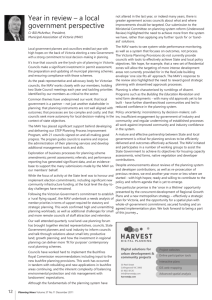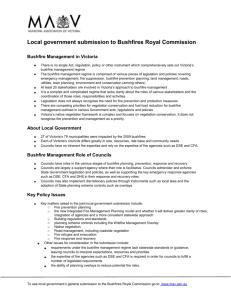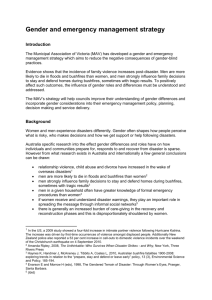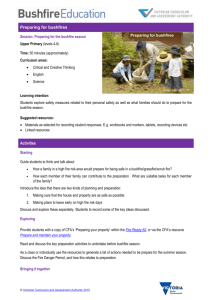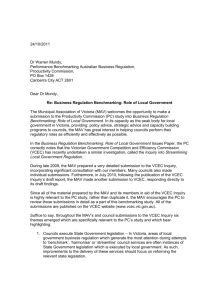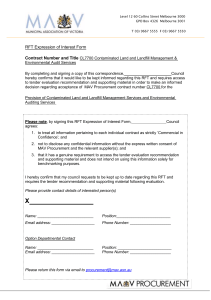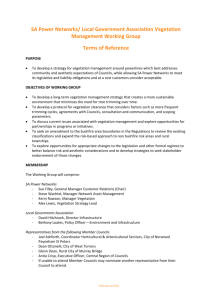Royal Commission final report - Municipal Association of Victoria
advertisement
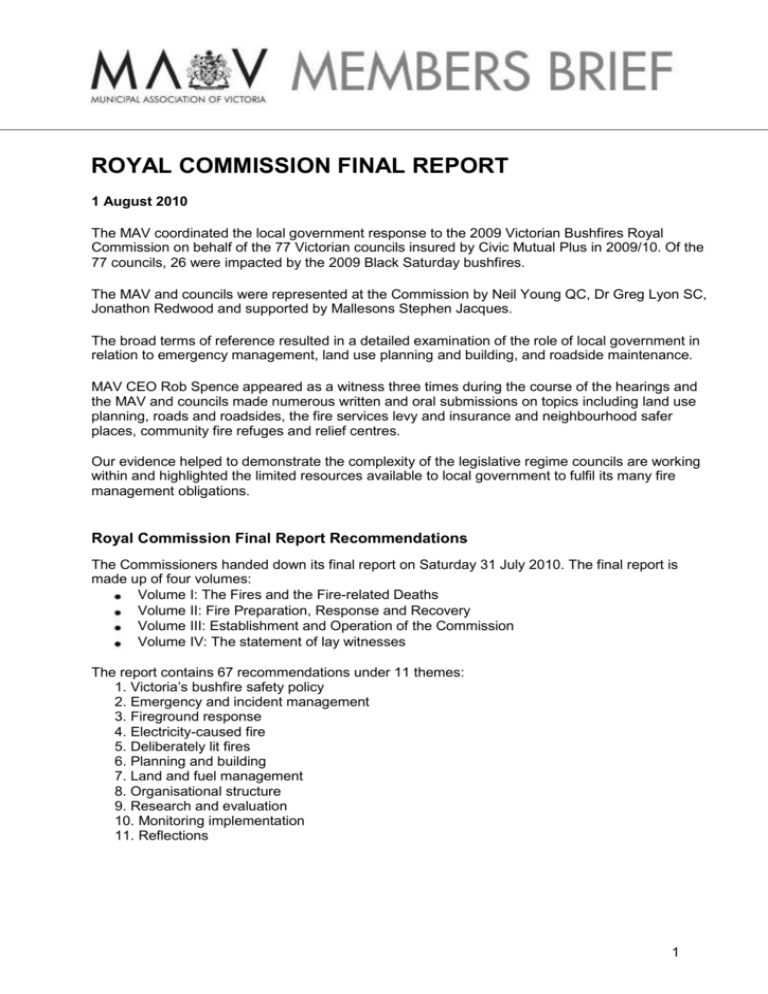
ROYAL COMMISSION FINAL REPORT 1 August 2010 The MAV coordinated the local government response to the 2009 Victorian Bushfires Royal Commission on behalf of the 77 Victorian councils insured by Civic Mutual Plus in 2009/10. Of the 77 councils, 26 were impacted by the 2009 Black Saturday bushfires. The MAV and councils were represented at the Commission by Neil Young QC, Dr Greg Lyon SC, Jonathon Redwood and supported by Mallesons Stephen Jacques. The broad terms of reference resulted in a detailed examination of the role of local government in relation to emergency management, land use planning and building, and roadside maintenance. MAV CEO Rob Spence appeared as a witness three times during the course of the hearings and the MAV and councils made numerous written and oral submissions on topics including land use planning, roads and roadsides, the fire services levy and insurance and neighbourhood safer places, community fire refuges and relief centres. Our evidence helped to demonstrate the complexity of the legislative regime councils are working within and highlighted the limited resources available to local government to fulfil its many fire management obligations. Royal Commission Final Report Recommendations The Commissioners handed down its final report on Saturday 31 July 2010. The final report is made up of four volumes: Volume I: The Fires and the Fire-related Deaths Volume II: Fire Preparation, Response and Recovery Volume III: Establishment and Operation of the Commission Volume IV: The statement of lay witnesses The report contains 67 recommendations under 11 themes: 1. Victoria’s bushfire safety policy 2. Emergency and incident management 3. Fireground response 4. Electricity-caused fire 5. Deliberately lit fires 6. Planning and building 7. Land and fuel management 8. Organisational structure 9. Research and evaluation 10. Monitoring implementation 11. Reflections 1 Challenges for Local Government Over the weekend, the MAV has identified a number of recommendations that we believe represent significant challenges for councils. These include: Planning for and lists of vulnerable people (recommendation 3) Neighbourhood Safer Places and Fire Refuges (recommendations 3 and 4) Planning for evacuation (recommendations 3, 4 and 5) Hazardous trees (Recommendation 30 and 31) Resettlement strategy (recommendation 46) Monitoring of planning permits (recommendation 52) Fire Services Levy (Recommendation 64) Local government funding and resources (no specific recommendation) Integrated Fire Management Planning (no specific recommendation) While this list is not exhaustive, the MAV recommends that councils consider these issues ahead of the briefing session for councils at 3.30pm, 4 August 2010 at Mallesons Stephen Jacques, level 50, 600 Bourke Street, Melbourne. These matters, together with other issues subsequently identified by the MAV, Mallesons and member councils will be further examined at this session to help inform and guide our response to the State Government’s consultation process over the coming weeks. Victoria’s Bushfire Safety Policy There are seven recommendations relating to the Bushfire Safety Policy. While there is no specific recommendation relating to Integrated Fire Management Planning (IFMP), the report emphasises the need for integrated, local planning, lead by councils with adequate resources and support, and better guidance, from the State Government. The Commission advocates a closer connection between municipal emergency management planning, municipal fire prevention/management planning and township protection planning, and urges the State to give priority to the roll-out of IFMP. The Commissioners also suggest that councils should take a lead role in evacuation planning, as well as assessing and providing bushfire shelter options. Recommendations 1 and 2 relate to the revision and communication of the policy. The Commission acknowledged that there are elements of the current ‘Prepare, Stay and Defend or Leave Early’ policy that are sound and should be retained, however it was recommended that both the policy approach and the community bushfire safety education be revised. MAV input at Commission: The bushfire policy is primarily a state responsibility. Councils will help implement and communicate the policy as appropriate. To the extent that any new bushfire policy involves an increase in responsibilities for councils, there must be a commensurate increase in resources made available to councils. Recommendation 3: The State establish mechanisms for helping municipal councils to undertake local planning that tailors bushfire safety options to the needs of individual communities. In doing this planning, councils should: urgently develop for communities at risk of bushfire local plans that contain contingency options such as evacuation and shelter 2 document in municipal emergency management plans and other relevant plans facilities where vulnerable people are likely to be situated—for example, aged care facilities, hospitals, schools and child care centres compile and maintain a list of vulnerable residents who need tailored advice of a recommendation to evacuate and provide this list to local police and anyone else with prearranged responsibility for helping vulnerable residents evacuate. MAV input at Commission: In relation to local plans, it was submitted that councils would support this proposal if the Emergency Management Manual Victoria (EMMV) and legislation were amended so that the responsibilities of all relevant agencies in preparing and implementing such plans are recognised. Accountability for planning at the municipal level must be shared by all those who contribute to it. It was also submitted that: Plans should be developed through the Integrated Fire Management Planning process; Any plans should be prepared and approved by the relevant agencies, Municipal Emergency Management Planning Committee (MEMPC) and Municipal Fire Prevention Committee (MFPC) or Municipal Fire Management Planning Committee (MFMPC); More resources would need to be provided for the enormous work required to develop multiple plans; and Facilities such as aged care facilities, hospitals, schools and child care centres are already listed in many plans and are being mapped through the Victorian Fire Risk Register. Regarding lists of vulnerable people, the recommendation that councils become responsible for compiling and maintaining lists was not supported for the following reasons: Lists should be maintained by those agencies with responsibility to recommend evacuation There should be a central, state-held database for this list, which is not organised (and limited) by reference to municipal boundaries The State already funds the Office of Senior Victorians (DPCD) and Victoria Police to develop ‘opt-in’ community registers It was submitted that councils would assist in compilation of the lists, but not be sole custodians – eg recommending to council clients such as HACC recipients that they opt-in. Recommendation 4: The State introduce a comprehensive approach to shelter options that includes the following: developing standards for community refuges as a matter of priority and replacing the 2005 Fire Refuges in Victoria: Policy and Practice designating community refuges—particularly in areas of very high risk—where other bushfire safety options are limited working with municipal councils to ensure that appropriate criteria are used for bushfire shelters, so that people are not discouraged from using a bushfire shelter if there is no better option available acknowledging personal shelters around their homes as a fallback option for individuals. The report also recommended changing the term Neighbourhood Safer Place to ‘bushfire shelter’. MAV input at Commission: We supported a comprehensive approach to shelter options, however: disagree with the finding in the report that the term Neighbourhood Safer Place (NSP) should change to ‘bushfire shelter’ ahead of the 2010/11 fire season. While councils have reservations about the current name, a name change at this stage could cause considerable community confusion; using the term ‘shelter’ would be misleading when many NSPs are open spaces; 3 the current warning sign for NSPs is necessary to explain to potential users the inherent risks associated with using an NSP as a ‘place of last resort’; and before fire refuges are reintroduced as a safety option, funding and liability issues must be resolved by the State Government. Recommendation 5: The State introduce a comprehensive approach to evacuation, so that this option is planned, considered and implemented when it is likely to offer a higher level of protection than other contingency options. The approach should: encourage individuals—especially vulnerable people—to relocate early include consideration of plans for assisted evacuation of vulnerable people recommend ‘emergency evacuation’. MAV input at Commission: The MAV put forward the concerns of councils in relation to evacuation planning and managed evacuation. We submitted that any proposed provision for managed evacuation is a matter for agencies with the power to order evacuation, in particular Victoria Police and that: councils would support the Incident Controller being responsible for assessing whether evacuation is necessary; responsibility for alerting and managing the evacuation of vulnerable people should not be a council responsibility; evacuation for any community should be communicated to the relevant Municipal Emergency Coordination Centre (MECC); and if evacuation is to be contemplated, the capability of all roads and tracks in rural Victoria must be considered to support the evacuation and taken into account with any operating procedures determined by the Country Fire Authority (CFA) and Department of Sustainability and Environment (DSE). Recommendation 6 relates to an education program in schools and Recommendation 7 to the development of national bushfire policy. There were no MAV submissions made to the Commission on these issues. Emergency and Incident Management The Commission’s 12 recommendations focus on state-level emergency management and the need for more integration and strong and effective leadership. Fireground Response There are seven recommendations relating to personnel, resources and processes, mainly directed at the CFA and DSE. Electricity-Caused Fire The eight recommendations include one directed at councils: Recommendation 31: Municipal councils include in their municipal fire prevention plans for areas of high bushfire risk provision for the identification of hazard trees and for notifying the responsible entities with a view to having the situation redressed. The Commission defines ‘hazard trees’ as trees that stand outside both the regulated vegetation clearance (and regrowth) space around power lines that still pose a risk of causing fires by contacting power lines when they break or fall. 4 MAV input at Commission: This recommendation was not supported at the Commission because this could potentially place an enormous new burden upon councils to identify and remove hazardous trees, which councils do not have the resources to perform. Deliberately Lit Fires There were two recommendations relating to strategies to address and reduce arson. Planning and Building The Commission made 19 recommendations relating to planning, building and management of native vegetation. The recommendations relating to building are quite specific. More detail is required about how the planning recommendations will be implemented before the impact on councils can be articulated. Recommendation 37: The State identifies a central point of responsibility for and expertise in mapping bushfire risk to: review urgently the mapping criteria at present used by the Country Fire Authority to map the Wildfire Management Overlay, to ensure that the mapping used to determine building and planning controls is based on the best available science and takes account of all relevant aspects of bushfire risk map and designate Bushfire-prone Areas for the purposes of planning and building controls, in consultation with municipal councils and fire agencies finalise the alignment of site-assessment methods for planning and building purposes, taking into account bushfire risk to human safety as well as to property MAV input at Commission: The need for a broader State Bushfire Strategy to be undertaken by a central agency as well as improved bushfire risk mapping was put forward at the Commission. Councils highlighted the current deficiencies in methodologies for the application of Wildfire Management Overlays and the inconsistencies in approach in planning and building decisions. Councils identified that: the creation of a responsible agency for managing bushfire risk was welcomed, although councils queried whether DPCD was the appropriate agency; the central agency could have a broader role than mapping – such as to formulate strategic state planning policy and assist councils with translation into local planning schemes, make final decisions between bushfire risk and native vegetation removal permit applications; resolution of a single site assessment methodology (CFA and Building) was necessary to map and designate areas, and phase out the state-wide designation of bushfire prone areas; reconsideration of the appropriateness of the 100m buffer and proximity to public land and forest was required; additional resources would be required to apply Bushfire-prone Overlays as a consequence of new mapping. Recommendation 38: The State implement a regional settlement policy that: takes account of the management of bushfire risk, including that associated with small, undeveloped rural lots includes a process for responding to bushfire risk at the planning stage for new urban developments in regional cities, the process being similar to that used for new developments in Melbourne’s Urban Growth Zone. MAV input at Commission: Regional settlement policy was supported in principle subject to councils being consulted on precise details and involved in its formulation. Clarity about the expectations on councils regarding small lots was sought. 5 Recommendation 39: The State amend the Victoria Planning Provisions relating to bushfire to ensure that the provisions give priority to the protection of human life, adopt a clear objective of substantially restricting development in the areas of highest bushfire risk—giving due consideration to biodiversity conservation—and provide clear guidance for decision makers. The amendments should take account of the conclusions reached by the Commission and do the following: outline the State’s objectives for managing bushfire risk through land-use planning in an amended state planning policy for bushfire, as set out in clause 15.07 of the Victoria Planning Provisions allow municipal councils to include a minimum lot size for use of land for a dwelling, both with and without a permit, in a schedule to each of the Rural Living Zone, Green Wedge Zone, Green Wedge A Zone, Rural Conservation Zone, Farming Zone and Rural Activity Zone amend clause 44.06 of the Victoria Planning Provisions to provide a comprehensive Bushfireprone Overlay provision. MAV input at Commission: The ranking of policy objectives and clearer guidance on how to balance competing objectives was a key tenet of our Land Use Planning submission. Furthermore it was put that: a policy relating to undeveloped small rural lots was required an overarching Bushfire Risk Strategy at the State level was necessary to help inform any State or Local Planning Policy any revisions to the Wildfire Management Overlay should be tied to level of risk and be clearly defined and mapped benefits of linking local planning policy to bushfire planning as part of the MFPP and MEMP the time and cost to councils of amending planning schemes is high and support would be welcome. while councils mostly agreed to the need for local policy, they identified the need for an overarching Bushfire Risk Strategy at the State level, which should be broader than just State planning policy. we were unclear about the intent to provide the capacity for councils to specify minimum lot sizes as the restructure overlay can already achieve this outcome and were concerned to create expectations that dwellings may be constructed on under-sized lots. Councils previously supported revisions to clause 44.06 and wanted "highest risk areas" clearly defined and mapped. Recommendation 40: The Country Fire Authority amend its guidelines for assessing permit applications for dwellings, non-dwellings and subdivisions in the Bushfire-prone Overlay in order to accommodate the amendments to the Wildfire Management Overlay that are implemented as a result of recommendation 39 and make the guidelines available to municipal councils and the public. The revised guidelines should do the following: substantially restrict new developments and subdivisions in those areas of highest risk in the Bushfire-prone Overlay set out the CFA’s guidelines for assessing permit applications for dwellings, non-dwellings and subdivisions—including the minimum defendable space requirements for different risk levels clarify that the CFA will approve new developments and subdivisions only if the recommended bushfire protection measures - including the minimum defendable space can be created and maintained on a continuing basis emphasise the need for enduring permit conditions - in particular, conditions for the creation and maintenance of minimum defendable space to be maintained for the life of the development. 6 MAV input at Commission: Identified during the Commission that some aspects of this recommendation may be best expressed as State Planning Policy and then shown locally, such as retreat and resettlement areas; infrastructure protection; and measures to reduce bushfire risk to an acceptable level. Supported revisions to the Wildfire Management Overlay Applicant’s Kit and guidelines for CFA consideration Supported the continuation of the 10/30 vegetation management exemption as an interim measure until a comprehensive Bushfire Prone Area Overlay is completed. Recommendation 41: The State: amend the Victoria Planning Provisions to require that, when assessing a permit to remove native vegetation around an existing dwelling, the responsible authority and the Department of Sustainability and Environment, as referral authority, take into account fire hazard and give weight to fire protection purposes develop guidelines for determining the maximum level of native vegetation removal for bushfire risk mitigation, beyond which level the application would be rejected. MAV input at Commission: The MAV supported greater flexibility to require a permit to remove native vegetation to create a defendable space where particular environmental, landscape or land management attributes or constraints warrant consideration, presuming that the ‘10/30’ provisions would remain. Recommendation 42: The Department of Sustainability and Environment develop and administer a collective offset solution for individual landholders who are permitted to remove native vegetation for the purpose of fire protection. MAV input at Commission: This recommendation was supported. Recommendation 43: The Department of Sustainability and Environment conduct biodiversity mapping identifying flora, fauna and any threatened species throughout Victoria and make the results publicly available. The format used should be compatible with that used for Bushfire-prone Area mapping. MAV input at Commission: Improved and comprehensive mapping was supported. Recommendation 44: The Country Fire Authority produce for community guidance material on fire-resistant landscape and garden design, including a list of fire-resistant species. MAV input at Commission This was supported, however the MAV understands this information already exists in joint DSE/CFA guidelines which are not widely disseminated. 7 Recommendation 45: The State press municipal councils — in particular, Murrindindi Shire Council — to urgently adopt a bushfire policy in their Local Planning Policy Framework and incorporate bushfire risk management in their planning policies and strategies for rebuilding communities such as Marysville, Kinglake and others affected by the January–February 2009 fires. MAV input at Commission: Largely agreed with the need for local policy, however the MAV identified the need for an overarching Bushfire Risk Strategy at the State level, which should be broader than just State planning policy Where local policy may be required, we saw the need to link the bushfire local policy with the Municipal Fire Prevention Plan and Municipal Emergency Management Plan The time and cost of amending planning schemes was raised and we also advised that councils would welcome Ministerial support for amendments to introduce such schedules Recommendation 46: The State develop and implement a retreat and resettlement strategy for existing developments in areas of unacceptably high bushfire risk, including a scheme for non-compulsory acquisition by the State of land in these areas. MAV input at Commission: Councils have supported this in principle, however there were a number of issues identified including: resettlement would be complex and costly – it would have to be weighed against other treatment options the areas of unacceptably high bushfire risk would have to be well defined concerns about non-compulsory acquisition resulting in some residents selling and some staying, such as communities becoming unsustainable; smaller rate bases making it difficult to provide infrastructure; and adverse impact on the number of CFA volunteers Councils sought further consultation about this recommendation. Recommendation 51: The Victorian Building Commission, in conjunction with the Country Fire Authority, develop, publish and provide to the community and industry information about ways in which existing buildings in bushfire-prone areas can be modified to incorporate bushfire safety measures. MAV input at Commission: Supported, with no specific comments. Recommendation 52: The State develop and implement, in consultation with local government, a mechanism for signoff by municipal councils of any permit conditions imposed under the Bushfire-prone Overlay and the regular assessment of landowners’ compliance with conditions. MAV input at Commission: Previously raised no objection, subject to adequate resources and CFA involvement to improve compliance with planning permit conditions More broadly, councils raised questions regarding obligations to monitor and enforce compliance with permit conditions as Municipal Fire Prevention Officers do not have a role in enforcement of WMO permit conditions relating to water, access and fire-fighting capacity. Compliance monitoring and enforcement would raise significant resourcing issues. The MAV did not support merging of the planning and building regimes. 8 Recommendation 53: The State amend s.32 of the Sale of Land Act 1962 to require that a vendor’s statement include whether the land is in a designated Bushfire-prone Area, a statement about the standard (if any) to which the dwelling was constructed, the bushfire attack level assessment at the time of construction (where relevant) and a current bushfire attack level assessment of the site of the dwelling. MAV input at Commission: No specific comment made at Commission. Land and Fuel Management While it is disappointing that there is no specific recommendation about the need to increase funding for councils, on page 309 of Volume II, the Commission writes: “The State should ensure that councils are adequately supported through funding, training and technical assistance to discharge their bushfire risk management functions in relation to roads and roadsides and the safe use of roads during fires.” Recommendation 60: The State amend the exemptions in clause 52.17-6 of the Victoria Planning Provisions to ensure that the provisions allow for a broad range of roadside works capable of reducing fire risk and provide specifically for a new exemption where the purpose of the works is to reduce bushfire risk. MAV input at Commission Supported changes to the decision guidelines in Clause 52.17 "Native Vegetation of the Victorian Planning Provisions" to minimise fire hazard and give weight to fire protection purposes and for improved biodiversity mapping to be undertaken. Proposed recommendation 61: The State and Commonwealth provide for municipal councils adequate guidance on resolving the competing tensions arising from the legislation affecting roadside clearing and, where necessary, amend environment protection legislation to facilitate annual bushfire-prevention activities by the appropriate agencies. MAV input at Commission Councils have generally supported greater guidance and use of the 6 metre exemptions for strategic fuel breaks and roadside management. Recommendation 62: VicRoads implement a systematic statewide program of bushfire risk assessment for all roads for which it is responsible, to ensure conformity with the obligations in s.43 of the Country Fire Authority Act 1958 and with the objectives expressed in the VicRoads 1985 Code of Practice. MAV input at Commission Council supported in principle, while acknowledging this recommendation related to VicRoads. Further detail in relation to how this recommendation can be implemented is required. 9 Organisational Structure There are two recommendations relating to organisational structure. Recommendation 63 recommended two statutory appointments: a Fire Commissioner as an independent statutory officer responsible to the Minister for Police and Emergency Services and as the senior operational firefighter in Victoria; and make the Chief Fire Officer of the Department of Sustainability and Environment a statutory appointment. One of the Fire Commissioner’s responsibilities would be to provide advice on the Metropolitan Fire District boundaries. MAV input at Commission The draft recommendation put forward by Counsel Assisting recommended a new Victorian Fire Services Board, which the MAV supported in principle while stating organisational structure is a matter for the State Government to determine. It was acknowledged that some change to the Metropolitan Fire District (MFD) is inevitable given urban expansion, however our submission outlined a number of considerations regarding a change to the MFD boundary, including the contribution to the community of CFA volunteers; the financial disincentive to opt into the MFD because of the current Fire Services Levy model; and concerns about the delivery of services. Recommendation 64: The State replace the Fire Services Levy with a property-based levy and introduce concessions for low-income earners. MAV input at Commission: The MAV supported introduction of a property-based levy, but considers that the levy should be collected through the Land Tax/State collection mechanism instead of through councils rates. Research and Evaluation The Commission recommended that the Commonwealth establish a national centre for bushfire research in collaboration with other Australian jurisdictions. Monitoring Implementation The Commission recommended that the State appoint an independent monitor or the Victorian Auditor-General to assess progress with implementing the Commission’s recommendations and report to the Parliament and the people of Victoria by 31 July 2012. Reflections It was recommended that the State consider the development of legislation for the conduct of inquiries in Victoria – in particular, the conduct of royal commissions. FURTHER INFORMATION Website link: The report is available at www.royalcommission.vic.gov.au Submission of the MAV and 77 councils are available at www.mav.asn.au/royalcommission MAV contact person: Emma Fitzclarence Phone Number: 9667 5532 Email: efitzclarence@mav.asn.au 10
